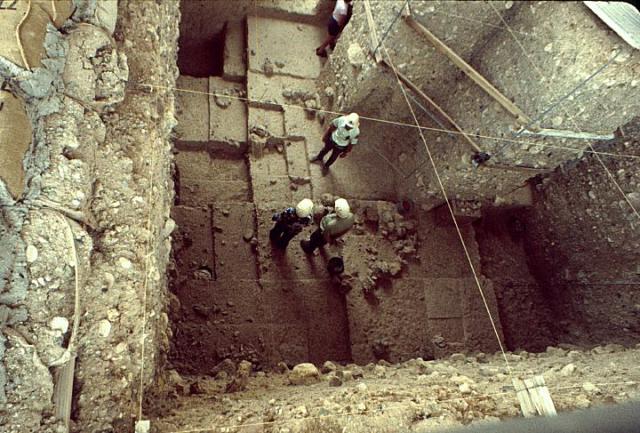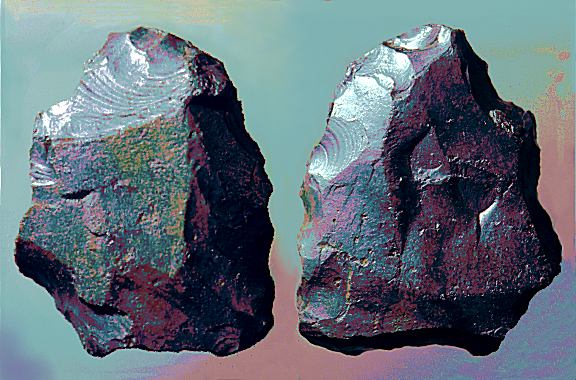Early Man Site
One of the more unique road signs you'll see between L.A. and Las Vegas is one that announces the nearby presence of an "Early Man Site."
 [Image: The excavation pit at Calico; photo by D. Griffin].
[Image: The excavation pit at Calico; photo by D. Griffin].
"One of the most controversial archaeological sites in the Western Hemisphere," we read, courtesy of the Calico Early Man Site website, "is located in the Mojave Desert of California, near the town of Barstow. The site, in low hills east of the Calico Mountains, displays evidence for the presence of tool-making humans in the Americas some 200,000 years ago, far earlier than any Western Hemisphere site that has been accepted by the majority of the archaeological community."
Though no human remains have ever been found there, and the stone tools themselves are suspiciously rock-like, "It is hoped that [the region] may someday reveal early human remains, becoming America's Olduvai Gorge."
"The history of this site dates back to 1942," the Bureau of Land Management explains, "when amateur archaeologists discovered what they believed to be primitive stone tools in this area. Fragments were embedded in the sediments of the shoreline of an ancient Pleistocene Era lake, called Lake Manix."
Incredibly, famed anthropologist Louis Leakey once worked at the site – though his wife, Mary, was apparently so unconvinced by its early dating that she tried to prevent Louis's excavations at Calico from being published.
 [Image: A Calico Cutter – but is it a rock or a shaped tool?].
[Image: A Calico Cutter – but is it a rock or a shaped tool?].
The phrase "Early Man Site," in and of itself, also interests me, in all of its politically incorrect self-assuredness. There appears to be only one other "official" Early Man Site in the world, and that's a UNESCO World Heritage Site in Indonesia. Aside from these two places, the phrase is simply used as a descriptive term for definable areas of prehistoric anthropological settlement.
But the seeming incongruity – the quasi-Ballardian nature – of seeing an Early Man Site so close to the American highway system (between L.A. and Vegas, no less) would not sound real if you had invented it.
Looking into this strange coincidence of American roadworks and ancient humanity further, I soon discovered that Caltrans – the California Department of Transportation – actually maintains a series of ongoing archaeological projects, including an official Archaeology Branch. They study landscape phenomena such as "the ruins of linear structures" (i.e. "road ruins").
There is even a Caltrans guide for how to identify a prehistoric site.
 [Image: The excavation pit at Calico; photo by D. Griffin].
[Image: The excavation pit at Calico; photo by D. Griffin]."One of the most controversial archaeological sites in the Western Hemisphere," we read, courtesy of the Calico Early Man Site website, "is located in the Mojave Desert of California, near the town of Barstow. The site, in low hills east of the Calico Mountains, displays evidence for the presence of tool-making humans in the Americas some 200,000 years ago, far earlier than any Western Hemisphere site that has been accepted by the majority of the archaeological community."
Though no human remains have ever been found there, and the stone tools themselves are suspiciously rock-like, "It is hoped that [the region] may someday reveal early human remains, becoming America's Olduvai Gorge."
"The history of this site dates back to 1942," the Bureau of Land Management explains, "when amateur archaeologists discovered what they believed to be primitive stone tools in this area. Fragments were embedded in the sediments of the shoreline of an ancient Pleistocene Era lake, called Lake Manix."
Incredibly, famed anthropologist Louis Leakey once worked at the site – though his wife, Mary, was apparently so unconvinced by its early dating that she tried to prevent Louis's excavations at Calico from being published.
 [Image: A Calico Cutter – but is it a rock or a shaped tool?].
[Image: A Calico Cutter – but is it a rock or a shaped tool?].The phrase "Early Man Site," in and of itself, also interests me, in all of its politically incorrect self-assuredness. There appears to be only one other "official" Early Man Site in the world, and that's a UNESCO World Heritage Site in Indonesia. Aside from these two places, the phrase is simply used as a descriptive term for definable areas of prehistoric anthropological settlement.
But the seeming incongruity – the quasi-Ballardian nature – of seeing an Early Man Site so close to the American highway system (between L.A. and Vegas, no less) would not sound real if you had invented it.
Looking into this strange coincidence of American roadworks and ancient humanity further, I soon discovered that Caltrans – the California Department of Transportation – actually maintains a series of ongoing archaeological projects, including an official Archaeology Branch. They study landscape phenomena such as "the ruins of linear structures" (i.e. "road ruins").
There is even a Caltrans guide for how to identify a prehistoric site.





Comments are moderated.
If it's not spam, it will appear here shortly!
I got a degree in History from a CSU. There were a series of Public History classes where I was assigned to write the historical impact report for a proposed building project. It's a component and a parallel to an environmental impact report, it's just not nearly as sexy (history boring, environment MUST BE SAVED!)
The historical impact report had to include any pre-written historical evidence in the area, and that involved a field trip (across campus) to the local branch of the state archaeologist's office. They had maps and notes and could look at an address or map coordinates and say, "Yeah, twenty feet thataway is a rock of interest, and forty feet in the opposite direction fifteen arrowheads were found in 1975 at a depth of 10 feet..."
Shortly after I graduated, my parents decided to build a new home in an unincorporated area of California. They had to pay an archaeologist team $18,000 to come drill test holes looking for sites of prehistoric interest. Each hole was marked with a little red flag, 20 in all. After construction was complete, my mother would give the flags to people and say, "Here's a $900 gift."
Post a Comment